- Moroccan Interior Design: How I Learned to Stop Worrying and Love Bold Colors - September 4, 2025
- Modern Indian Design Style: When Tradition Meets Today’s Living - September 3, 2025
- Twenty Years of Getting Indian Traditional Design Wrong (And Finally Right) - September 3, 2025
Table of Contents
So there I was, standing in Mrs. Kapoor’s newly “traditional” living room in Gurgaon, watching her 8-year-old son try to do his math homework while balancing a notebook on his knees because we’d gone full-floor-seating everywhere. Her mother-in-law was struggling to get up from the low divan, and nobody could find the TV remote among all those “authentic” brass decorative bowls I’d insisted on.
That disaster happened in 2009, and honestly? Best thing that ever happened to my design career.
See, I’d just returned from London after studying interior design, full of textbook knowledge about “Indian traditional elements” and zero understanding of how real Indian families actually live. I was cramming every traditional element I could think of into spaces without considering whether they made sense for people who have school pick-ups, work calls, and yes, Netflix nights.
The Day Everything Clicked
Fast forward three years. I’m sitting in my client Priya Aunty’s kitchen in Chennai (she insisted I call her that after our second meeting). She’s making filter coffee and telling me about her daughter’s upcoming wedding preparations. Her kitchen was this beautiful blend of traditional and practical – copper vessels displayed on open shelves, a granite countertop with stove perfect for making dosa batter, and closed cabinets that kept everything neatly organized.
“Beta,” she said, handing me the coffee in a traditional tumbler and davara, “tradition isn’t about using old things. It’s about understanding why our grandmothers made certain choices and deciding what still makes sense today.”
That sentence changed everything.
Here’s the picture of the kitchen.
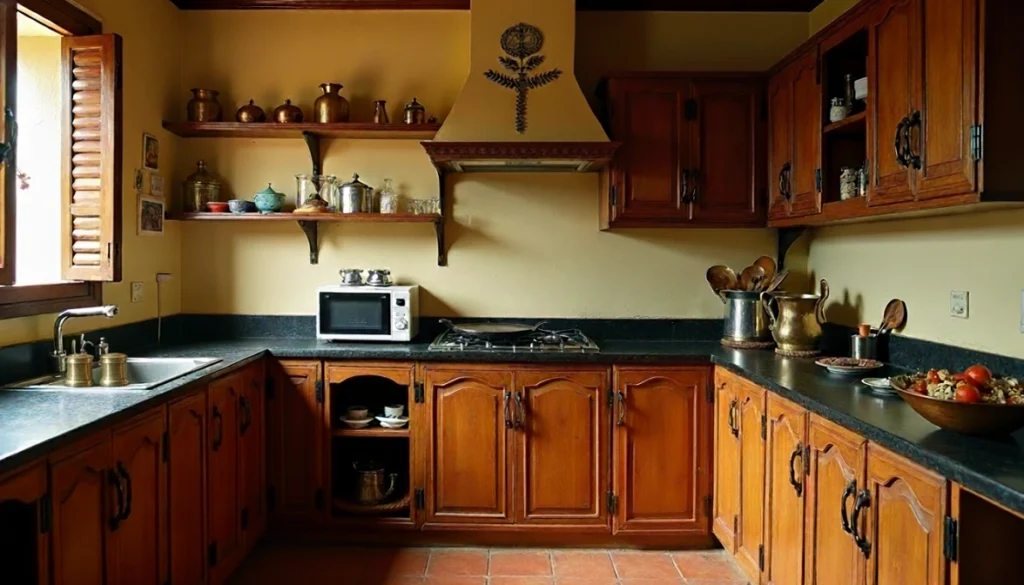
What I Wish Someone Had Told Me Earlier
Indian traditional design isn’t costume play. It’s not about making your home look like a heritage hotel lobby. It’s about creating spaces that honor cultural wisdom while serving your actual lifestyle.
Take Vastu, for example. Everyone gets hung up on the directional stuff – bedroom in southwest, kitchen in southeast, whatever. But the real genius of Vastu is understanding natural light, air flow, and how different activities feel better in different parts of the home. Your morning prayer corner benefits from east-facing light not because of mystical reasons, but because morning light actually does make you feel more energetic and positive.
Color choices? They’re not random either. The deep blues traditional in Rajasthani homes aren’t just pretty – they’re cooling in desert heat. The warm yellows popular in South Indian homes reflect the abundant sunlight and create cozy spaces during monsoon months.
But here’s what took me years to understand: you don’t have to follow these traditions blindly. If you live in Mumbai’s humidity, maybe those heavy silk drapes traditional in North Indian homes don’t make sense. Adapt the principle (rich textures, beautiful colors) to materials that work in your climate.
Room By Room: What Actually Works
Living Areas: Beyond the Pinterest Pictures
My most successful living rooms don’t look like magazine spreads. They look lived-in because, well, they are.
The Sharma family in Pune taught me this lesson. Dad works from home, mom teaches online classes, teenage daughter practices classical music, and grandmother loves her afternoon TV serials. One “traditional” seating arrangement wasn’t going to cut it.
We created zones instead. Near the window: a comfortable chair with good light for dad’s reading and work calls. Center of the room: a sectional sofa (yes, traditional homes can have sofas!) covered in beautiful handloom fabric for family movie nights. In one corner: floor seating with bolsters for music practice and when friends come over.
The traditional elements? Brass accents, carved wooden side tables, handwoven rugs, and beautiful textiles. But arranged around how this family actually lives.
Lighting was key. Instead of one harsh overhead fixture, we used multiple sources – a statement brass hanging lamp over the main seating area, table lamps for reading, and traditional brass diyas for festivals. Dimmers everywhere because different activities need different moods.
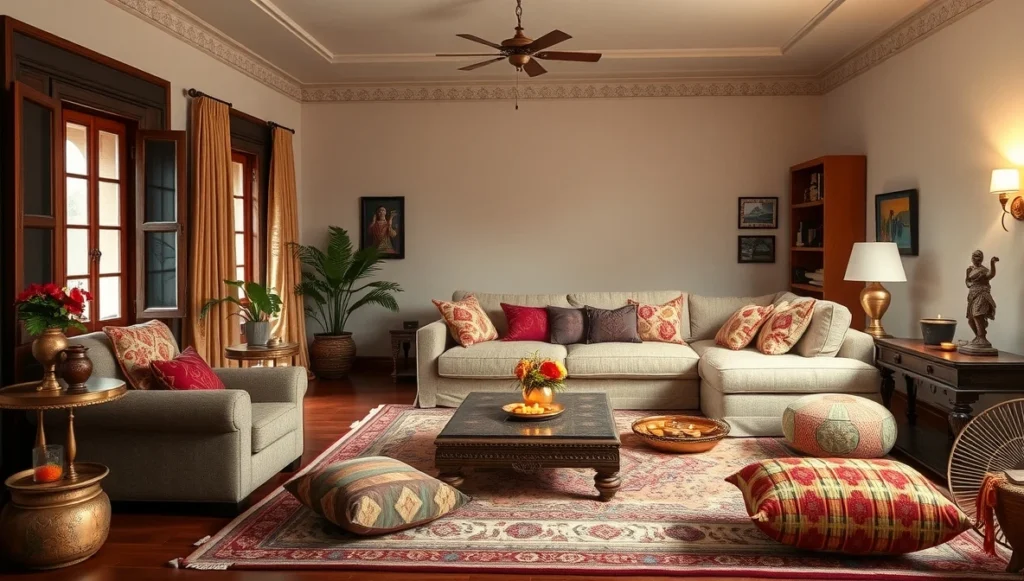
Kitchens: Where Culture Meets Convenience
Indian cooking is complicated. We need space for grinding, rolling, frying, pressure cooking, and storing approximately 47 different spices. Traditional kitchen design understood this.
Modern Indian kitchens need to honor these practices while accommodating dishwashers, microwaves, and the reality that both parents probably work full-time.
My favorite kitchen project was for the Agarwals in Bangalore. Rashmi wanted to honor her Gujarati heritage but also needed efficiency for her busy schedule. We designed a central island with granite top – perfect for rolling rotis and grinding chutneys. Around the perimeter: modern cabinets designed to look like traditional carved panels.
The genius was in the details. Spice storage in beautiful brass containers within easy reach of the stove. A dedicated area for storing and displaying traditional brass and copper vessels. Open shelving for daily-use items in attractive containers rather than hiding everything behind cabinet doors.
And yes, a small prayer corner with space for tulsi plant and morning aarti. Not because it’s required, but because starting the day with that moment of gratitude actually improves how you feel about cooking for your family.
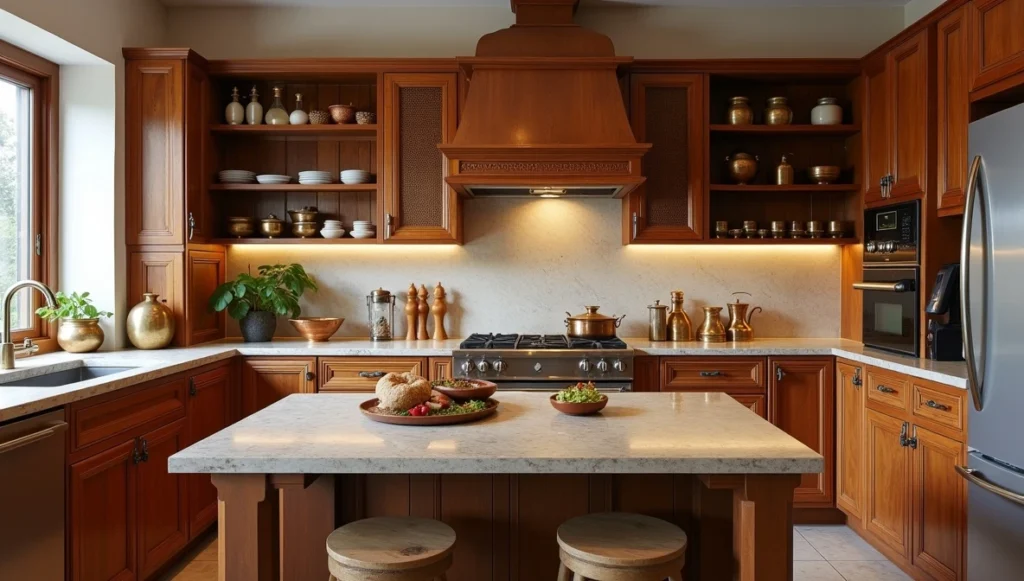
Bedrooms: Getting Sleep Right
Bedroom design mistakes are the most expensive because they affect your daily rest. I learned this the hard way when clients started calling me complaining about poor sleep after I’d repositioned their beds according to “traditional principles” without considering their actual room layouts.
Now I focus on practical comfort first, then add traditional elements that enhance rather than compromise good sleep.
The bed itself matters enormously. Platform beds made from solid wood (sheesham is great for budgets, teak if you can afford it) create a sense of grounding that metal frames just don’t provide. But the height needs to be right for people getting in and out easily, especially older family members.
Textiles make the biggest visual impact for the least money. Handloom cotton sheets feel better and last longer than synthetic ones. Throws and cushions in traditional prints can completely change a room’s mood while being easy to swap seasonally.
Storage is where traditional design really shines. Beautiful wooden wardrobes with carved details feel so much more special than standard built-ins. They’re investment pieces that improve with age rather than looking dated after a few years.
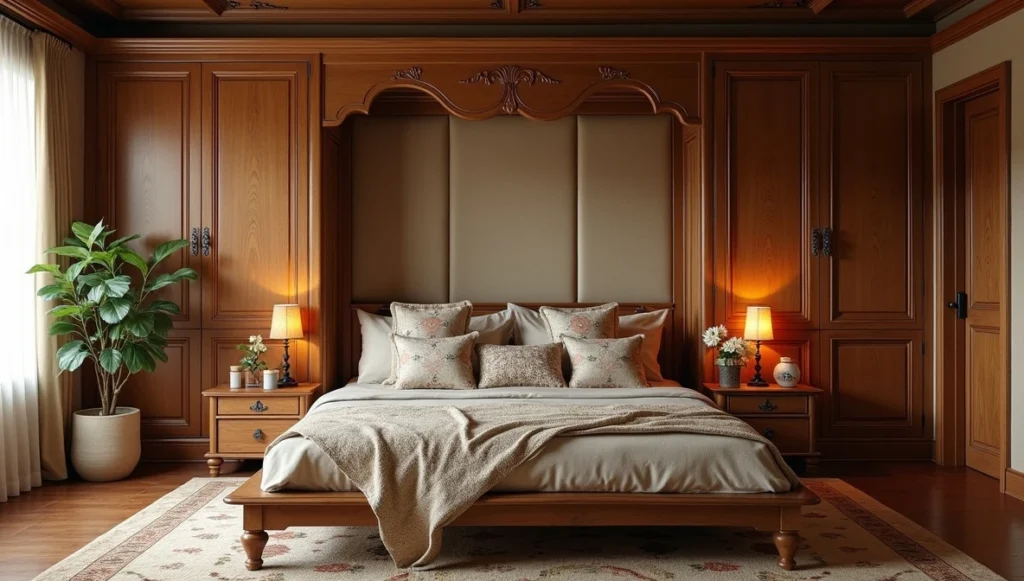
Dining: Making Meals Matter
The dining room the Jains wanted in their Delhi home seemed impossible at first. Joint family of 12 people, ranging from a toddler to 85-year-old grandfather, wanting to maintain traditional values while accommodating everyone’s needs.
We ended up with an expandable wooden table that seats 6 for daily meals but extends to accommodate 14 during festivals. Chairs varied in height and style – some standard dining chairs for older family members, some lower seating options for people who prefer traditional postures.
The real traditional element was the approach: designing around food as a communal, celebratory experience rather than just refueling. Beautiful serving pieces displayed where they can be easily accessed. Warm colors that stimulate appetite and conversation. Lighting that makes food look appealing and faces look warm.
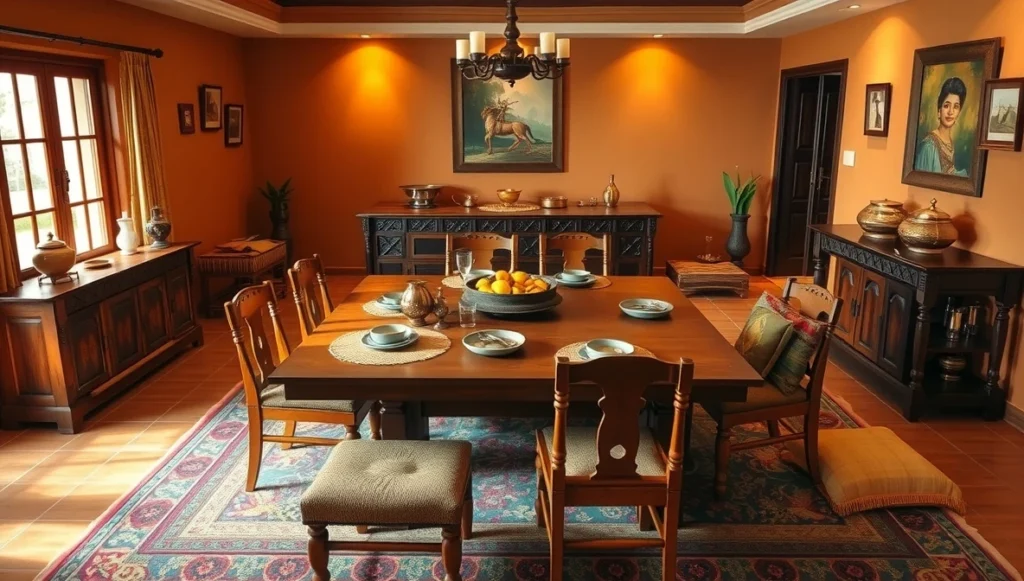
Bathrooms: Beyond Basic Function
Traditional Indian bathing practices are about wellness, not just getting clean. Oil massage, natural scrubs, the ritualistic aspects of personal care – these practices are experiencing a revival as people recognize their mental health benefits.
Modern bathrooms can support these practices through thoughtful design. Natural stone surfaces that feel good underfoot. Storage for copper vessels, natural beauty products, essential oils. Adequate ventilation that doesn’t require harsh exhaust fans.
The bathroom I designed for Dr. Krishnan’s Chennai home included a small area with wooden seating for oil massage before bathing, storage for traditional beauty ingredients his wife prepares herself, and brass fixtures that develop beautiful patina over time.
Practical luxury rather than showiness. Materials that age gracefully rather than requiring constant replacement.
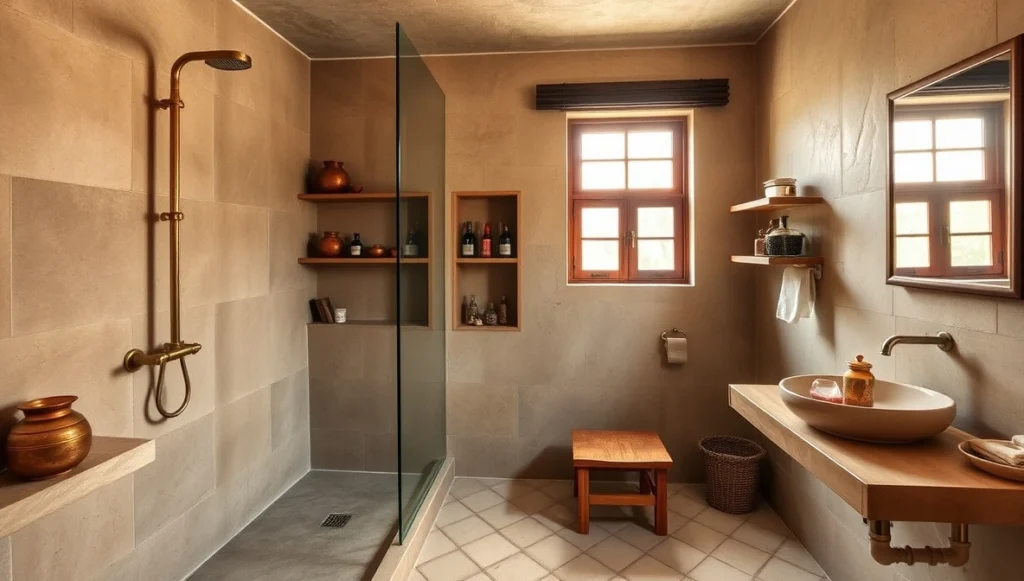
Prayer Spaces: Sacred and Personal
Every home needs a space for quiet reflection, whether you’re religiously inclined or not. The prayer room isn’t about displaying devotion; it’s about creating moments of peace in chaotic daily life.
Location matters, but common sense trumps rigid rules. Northeast corner is traditional, but if that’s your noisy kitchen area, find another quiet spot. More important is creating a space that feels separate from household chaos.
Keep it simple. Marble or wood platform, good ventilation, soft lighting, storage for items used during prayer or meditation. The most beautiful prayer rooms I’ve designed feel peaceful rather than ornate.
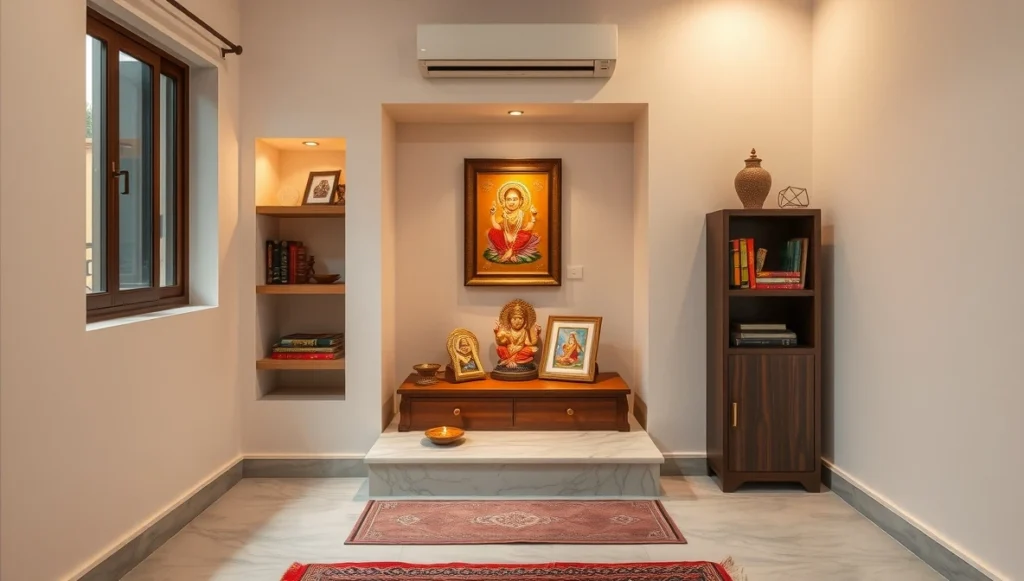
Home Offices: Tradition Meets Technology
Working from home is now normal, but most people are trying to work from dining tables or bedrooms. A dedicated workspace improves productivity and helps maintain work-life balance.
Traditional craftsmanship in office furniture creates a sense of permanence and quality that supports focused work. A well-made wooden desk with carved details becomes daily inspiration rather than mere function.
But technology integration is crucial. Traditional carved panels can hide modern cable management. Beautiful wooden boxes organize supplies. Brass desk accessories feel special while serving practical purposes.
The home office I designed for Amit in Mumbai combines a traditional teak desk with modern ergonomic seating, hidden cable management, and traditional storage solutions that organize modern work supplies.
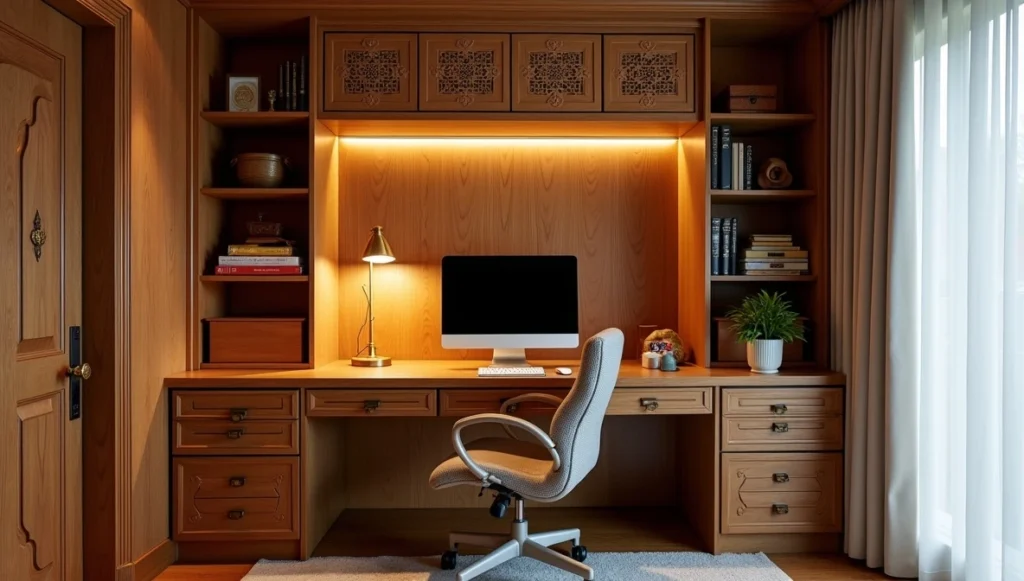
My Biggest Expensive Mistakes (So You Don’t Make Them)
Mistake #1: Mixing every Indian region in one space. The Rajasthani mirror work, Kashmiri carpets, South Indian bronze, and Bengali textiles all in one living room looked like a craft store exploded. Pick one regional influence and explore it deeply.
Mistake #2: All brass everything. Yes, brass is beautiful and traditional. But too much brass makes spaces feel like temple gift shops. Balance brass with wood, textiles, stone, and other materials.
Mistake #3: Ignoring actual furniture needs. That gorgeous carved wooden swing might be traditional and beautiful, but if nobody in your family will actually use it, it’s just expensive decoration taking up space.
Mistake #4: Prioritizing appearance over comfort. Floor seating looks authentic, but if your family ends up with back pain and migrates to the sofa anyway, you’ve wasted money and created frustration.
What’s Changed in the Last Five Years
Last five years have been wild in terms of what clients are asking for. The twenty-somethings especially – they’re not interested in recreating their grandparents’ homes exactly. They want to understand the WHY behind traditional choices and then make their own decisions.
Take sustainability, for example. Suddenly everyone’s worried about fast furniture and environmental impact. Guess what’s been sustainable all along? Traditional craftsmanship. Solid wood furniture that lasts decades instead of IKEA pieces that fall apart in two years. Natural textiles you can compost instead of synthetic fabrics that never biodegrade. Brass vessels you can repair indefinitely instead of plastic containers you throw away.
The most successful homes I’m designing now tell specific family stories rather than generic “we are Indian” stories. Like incorporating that vintage trunk from grandfather’s travels, or displaying the brass collection grandmother started, or using textiles from the family’s home state rather than just whatever looks “traditional.”
It’s getting personal again, which honestly makes my job way more interesting.
Starting Your Own Traditional Journey
Don’t be like me in 2008, trying to redo an entire house in one go and ending up with a beautiful mess that nobody could actually live in.
Start small. Pick the room where your family spends the most time – usually the living room or kitchen – and focus there first. Get that right before moving on.
Go meet actual craftspeople. I know it’s easier to order everything online, but spending a morning with a brass worker in Moradabad or a textile weaver in Varanasi changes how you understand these materials. Plus, you’ll make better choices when you know the stories behind the techniques.
Think about your family’s actual rhythms. Do you gather for meals? Then invest in a proper dining setup. Have morning or evening prayers? Create a peaceful corner for that. Love hosting friends? Design for comfortable socializing.
Most importantly – your home should work for your life, not against it. If something is beautiful but impractical for your family, it’s decoration masquerading as design. And trust me, you’ll resent it within six months.
The goal isn’t to recreate your great-grandmother’s house. It’s to honor the wisdom behind her design choices while creating a space that serves your contemporary needs. That’s not compromise – that’s evolution.
